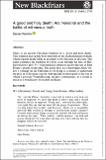Files in this item
A good and holy death : Ars moriendi and the battle of wit versus truth
Item metadata
| dc.contributor.author | Rentfro, Daniel | |
| dc.date.accessioned | 2022-11-08T11:30:03Z | |
| dc.date.available | 2022-11-08T11:30:03Z | |
| dc.date.issued | 2022-11-23 | |
| dc.identifier | 281861907 | |
| dc.identifier | 0ed143b6-b8e7-4d97-a3cc-f7a3b5a1ad2c | |
| dc.identifier | 000879544700001 | |
| dc.identifier.citation | Rentfro , D 2022 , ' A good and holy death : Ars moriendi and the battle of wit versus truth ' , New Blackfriars , vol. 103 , no. 1108 , pp. 730-744 . https://doi.org/10.1111/nbfr.12789 | en |
| dc.identifier.issn | 0028-4289 | |
| dc.identifier.uri | https://hdl.handle.net/10023/26324 | |
| dc.description.abstract | There is an ancient Christian tradition of a ‘good and holy death’. That tradition has largely been forgotten in the medicalization of death, which regards death solely as an enemy to be defeated at all costs. This paper examines the tradition of a holy death through the lens of Margaret Edson's play W;t, with particular attention paid to the use of John Donne's poetry in the play. The paper then uses theologian Allen Verhey's writings on the Christian art of dying as a means to understand the play in a Christian context, with special attention paid to the way in which it portrays Vivian Bearing, the play's protagonist, as a victim as much as a beneficiary of modern medicine. | |
| dc.format.extent | 15 | |
| dc.format.extent | 216887 | |
| dc.language.iso | eng | |
| dc.relation.ispartof | New Blackfriars | en |
| dc.subject | W;t | en |
| dc.subject | Christianity | en |
| dc.subject | Death and dying | en |
| dc.subject | John Donne | en |
| dc.subject | Allen Verhey | en |
| dc.subject | BR Christianity | en |
| dc.subject | T-NDAS | en |
| dc.subject | NIS | en |
| dc.subject | MCC | en |
| dc.subject.lcc | BR | en |
| dc.title | A good and holy death : Ars moriendi and the battle of wit versus truth | en |
| dc.type | Journal article | en |
| dc.contributor.institution | University of St Andrews. School of Divinity | en |
| dc.identifier.doi | 10.1111/nbfr.12789 | |
| dc.description.status | Peer reviewed | en |
This item appears in the following Collection(s)
Items in the St Andrews Research Repository are protected by copyright, with all rights reserved, unless otherwise indicated.

